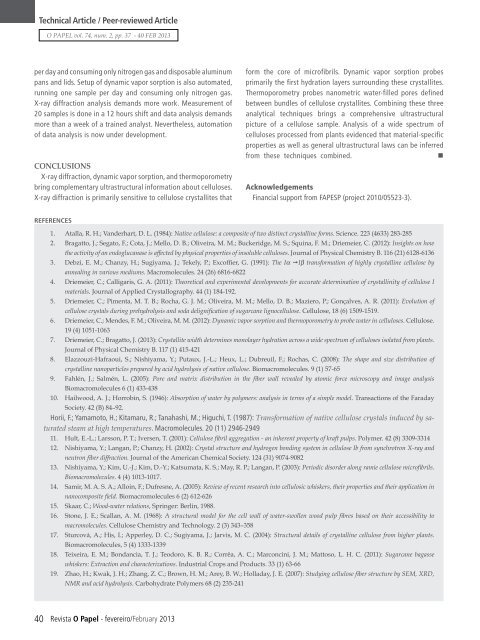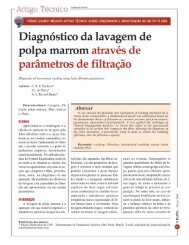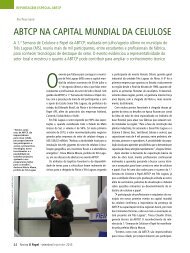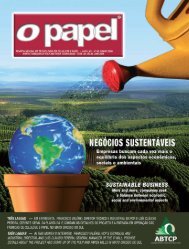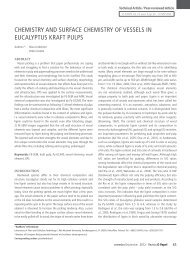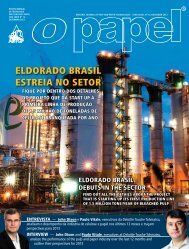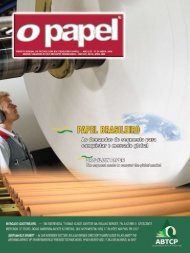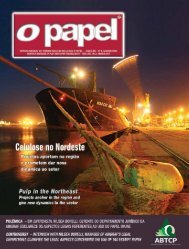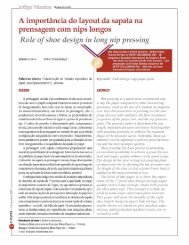A EVOLUÃÃO DA INDÃSTRIA DE CELULOSE E ... - Revista O Papel
A EVOLUÃÃO DA INDÃSTRIA DE CELULOSE E ... - Revista O Papel
A EVOLUÃÃO DA INDÃSTRIA DE CELULOSE E ... - Revista O Papel
You also want an ePaper? Increase the reach of your titles
YUMPU automatically turns print PDFs into web optimized ePapers that Google loves.
Technical Article / Peer-reviewed ArticleO PAPEL vol. 74, num. 2, pp. 37 - 40 FEB 2013per day and consuming only nitrogen gas and disposable aluminumpans and lids. Setup of dynamic vapor sorption is also automated,running one sample per day and consuming only nitrogen gas.X-ray diffraction analysis demands more work. Measurement of20 samples is done in a 12 hours shift and data analysis demandsmore than a week of a trained analyst. Nevertheless, automationof data analysis is now under development.CONCLUSIONSX-ray diffraction, dynamic vapor sorption, and thermoporometrybring complementary ultrastructural information about celluloses.X-ray diffraction is primarily sensitive to cellulose crystallites thatform the core of microfibrils. Dynamic vapor sorption probesprimarily the first hydration layers surrounding these crystallites.Thermoporometry probes nanometric water-filled pores definedbetween bundles of cellulose crystallites. Combining these threeanalytical techniques brings a comprehensive ultrastructuralpicture of a cellulose sample. Analysis of a wide spectrum ofcelluloses processed from plants evidenced that material-specificproperties as well as general ultrastructural laws can be inferredfrom these techniques combined.•AcknowledgementsFinancial support from FAPESP (project 2010/05523-3).REFERENCES1. Atalla, R. H.; Vanderhart, D. L. (1984): Native cellulose: a composite of two distinct crystalline forms. Science. 223 (4633) 283-2852. Bragatto, J.; Segato, F.; Cota, J.; Mello, D. B.; Oliveira, M. M.; Buckeridge, M. S.; Squina, F. M.; Driemeier, C. (2012): Insights on howthe activity of an endoglucanase is affected by physical properties of insoluble celluloses. Journal of Physical Chemistry B. 116 (21) 6128-61363. Debzi, E. M.; Chanzy, H.; Sugiyama, J.; Tekely, P.; Excoffier, G. (1991): The Iα •Iβ transformation of highly crystalline cellulose byannealing in various mediums. Macromolecules. 24 (26) 6816-68224. Driemeier, C.; Calligaris, G. A. (2011): Theoretical and experimental developments for accurate determination of crystallinity of cellulose Imaterials. Journal of Applied Crystallography. 44 (1) 184-192.5. Driemeier, C.; Pimenta, M. T. B.; Rocha, G. J. M.; Oliveira, M. M.; Mello, D. B.; Maziero, P.; Gonçalves, A. R. (2011): Evolution ofcellulose crystals during prehydrolysis and soda delignification of sugarcane lignocellulose. Cellulose, 18 (6) 1509-1519.6. Driemeier, C.; Mendes, F. M.; Oliveira, M. M. (2012): Dynamic vapor sorption and thermoporometry to probe water in celluloses. Cellulose.19 (4) 1051-10637. Driemeier, C.; Bragatto, J. (2013): Crystallite width determines monolayer hydration across a wide spectrum of celluloses isolated from plants.Journal of Physical Chemistry B. 117 (1) 415-4218. Elazzouzi-Hafraoui, S.; Nishiyama, Y.; Putaux, J.-L.; Heux, L.; Dubreuil, F.; Rochas, C. (2008): The shape and size distribution ofcrystalline nanoparticles prepared by acid hydrolysis of native cellulose. Biomacromolecules. 9 (1) 57-659. Fahlén, J.; Salmén, L. (2005): Pore and matrix distribution in the fiber wall revealed by atomic force microscopy and image analysisBiomacromolecules 6 (1) 433-43810. Hailwood, A. J.; Horrobin, S. (1946): Absorption of water by polymers: analysis in terms of a simple model. Transactions of the FaradaySociety. 42 (B) 84–92.Horii, F.; Yamamoto, H.; Kitamaru, R.; Tanahashi, M.; Higuchi, T. (1987): Transformation of native cellulose crystals induced by saturatedsteam at high temperatures. Macromolecules. 20 (11) 2946-294911. Hult, E.-L.; Larsson, P. T.; Iversen, T. (2001): Cellulose fibril aggregation - an inherent property of kraft pulps. Polymer. 42 (8) 3309-331412. Nishiyama, Y.; Langan, P.; Chanzy, H. (2002): Crystal structure and hydrogen bonding system in cellulose Ib from synchrotron X-ray andneutron fiber diffraction. Journal of the American Chemical Society. 124 (31) 9074-908213. Nishiyama, Y.; Kim, U.-J.; Kim, D.-Y.; Katsumata, K. S.; May, R. P.; Langan, P. (2003): Periodic disorder along ramie cellulose microfibrils.Biomacromolecules. 4 (4) 1013-1017.14. Samir, M. A. S. A.; Alloin, F.; Dufresne, A. (2005): Review of recent research into cellulosic whiskers, their properties and their application innanocomposite field. Biomacromolecules 6 (2) 612-62615. Skaar, C.; Wood-water relations, Springer: Berlin, 1988.16. Stone, J. E.; Scallan, A. M. (1968): A structural model for the cell wall of water-swollen wood pulp fibres based on their accessibility tomacromolecules. Cellulose Chemistry and Technology. 2 (3) 343–35817. Sturcová, A.; His, I.; Apperley, D. C.; Sugiyama, J.; Jarvis, M. C. (2004): Structural details of crystalline cellulose from higher plants.Biomacromolecules, 5 (4) 1333-133918. Teixeira, E. M.; Bondancia, T. J.; Teodoro, K. B. R.; Corrêa, A. C.; Marconcini, J. M.; Mattoso, L. H. C. (2011): Sugarcane bagassewhiskers: Extraction and characterizations. Industrial Crops and Products. 33 (1) 63-6619. Zhao, H.; Kwak, J. H.; Zhang, Z. C.; Brown, H. M.; Arey, B. W.; Holladay, J. E. (2007): Studying cellulose fiber structure by SEM, XRD,NMR and acid hydrolysis. Carbohydrate Polymers 68 (2) 235-24140 <strong>Revista</strong> O <strong>Papel</strong> - fevereiro/February 2013


